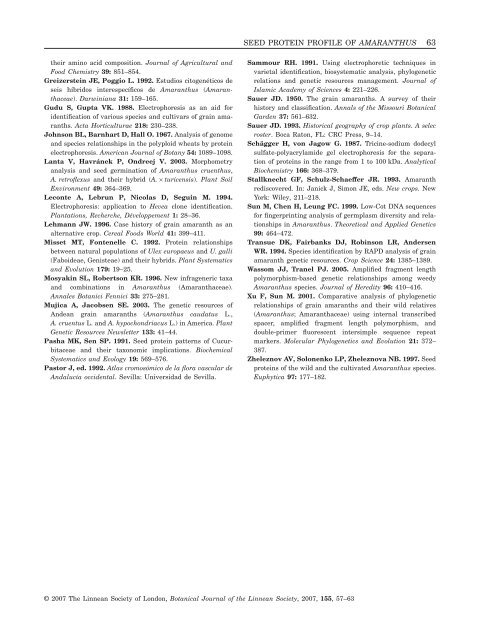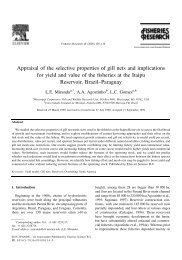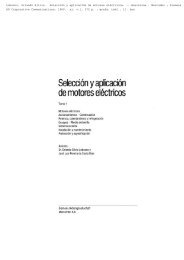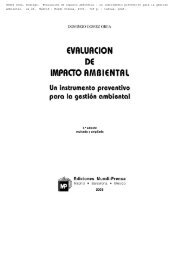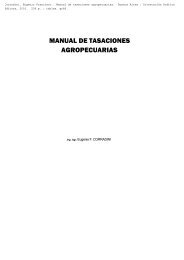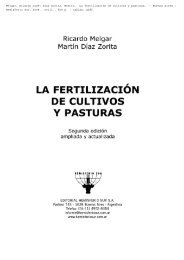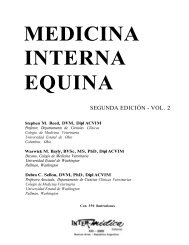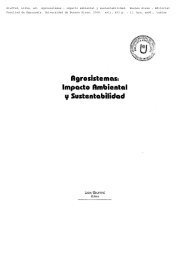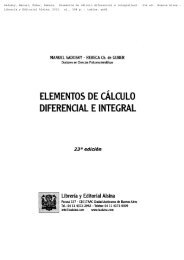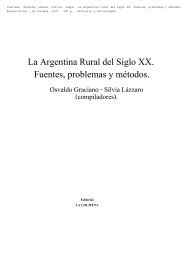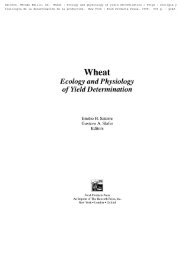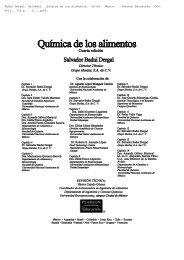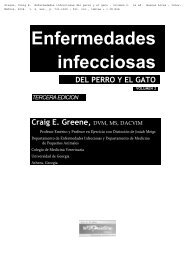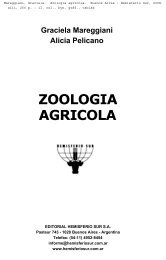62 R. JUAN ET AL.ACKNOWLEDGEMENTSWe thank M. Dolores Garcia for technical assistance.This work was supported by grant AGL 2004-03930.REFERENCESAbugoch LE, Martinez NE, Añón MC. 2003. Influence <strong>of</strong>the extracting solvent upon the structural properties <strong>of</strong>amaranth (<strong>Amaranthus</strong> hypochondriacus) glutelin. Journal<strong>of</strong> Agriculture <strong>and</strong> Food Chemistry 51: 4060–4065.Aellen P. 1959. <strong>Amaranthus</strong> L. In: Hegi G, ed. Illustrierteflora von Mitteleuropa, Vol. 2. München: Carl HanserVerlag, 465–516.Aiassa JP, Bonamico NC, Ibañez MC, Díaz DG,Gesumaría JJ, Di Renzo MA. 2003. Caracterizaciónmolecular de híbridos simples de maíz (Zea mays L.) medianteSSR. In: XXXII Congreso Argentino de Genética,Huerta Gr<strong>and</strong>e, Septiembre, 2003. Córdoba: Sociedad Argentinade Genética, 21–24.Altube H, Cabello F, Ortiz JM. 1991. Characterization <strong>of</strong>grape varieties <strong>and</strong> rootstocks by isoenzymes from woodyparts. Vitis 30: 203–212.Barba de la Rosa AP, Gueguen J, Paredes-López O,Viroben G. 1992. Fractionation procedures, electrophoretic<strong>characterization</strong>, <strong>and</strong> amino acid composition <strong>of</strong> amaranth<strong>seed</strong> <strong>proteins</strong>. Journal <strong>of</strong> Agricultural <strong>and</strong> Food Chemistry40: 931–936.Bradford MM. 1976. A rapid <strong>and</strong> sensitive method for thequantitation <strong>of</strong> microgram quantities <strong>of</strong> protein utilizing theprinciple <strong>of</strong> protein–dye binding. Analytical Biochemistry72: 248–254.Bravi R, Sommovigo A, Delogu C, Merisio G. 1994. Investigationon <strong>seed</strong> species identity <strong>of</strong> Lolium rigidum tradingin Italy. Sementi Elette 40: 11–17.Bray RJ, Curtis JI. 1957. An ordination <strong>of</strong> the upl<strong>and</strong> forestcommunities <strong>of</strong> southern Wisconsin. Ecological Monographs27: 325–349.Brenan JPM. 1961. <strong>Amaranthus</strong> in Britain. Watsonia 4:261–280.Bressani R. 1989. The <strong>proteins</strong> <strong>of</strong> grain amaranth. FoodResearch International 5: 13–38.Bressani R, García-Vela LA. 1990. Protein fractions inamaranth grain <strong>and</strong> their chemical <strong>characterization</strong>.Journal <strong>of</strong> Agricultural <strong>and</strong> Food Chemistry 38: 1205–1209.Búcaro-Segura ME, Bressani R. 2002. Distribución de laproteína en fracciones físicas de la molienda y tamizado delgrano del amaranto. Archivos Latinoamericanos de Nutrición52: 167–171.Carretero JL. 1979. El género <strong>Amaranthus</strong> en España. CollectaneaBotanica 11: 105–145.Carretero JL. 1990. <strong>Amaranthus</strong>. In: Castroviejo S, LainzM, López González G, Montserrat P, Muñoz Garmendia F,Paiva J, Villar L, eds. Flora Iberica plantas vasculares de laPenínsula Ibérica e Islas Baleares, Vol. 2. Madrid: RealJardín Botánico, C.S.I.C., 554–569.Chan KF, Sun M. 1997. Genetic diversity <strong>and</strong> relationshipsdetected by isozyme <strong>and</strong> RAPD analysis <strong>of</strong> crop <strong>and</strong> wildspecies <strong>of</strong> <strong>Amaranthus</strong>. Theoretical <strong>and</strong> Applied Genetics 95:865–873.Costea M, DeMason DA. 2001. Stem morphology <strong>and</strong>anatomy in <strong>Amaranthus</strong> L. (Amaranthaceae) – taxonomicsignificance. Journal <strong>of</strong> the Torrey Botanical Society 128:254–281.Costea M, S<strong>and</strong>ers A, Waines G. 2001a. Preliminary resultstoward a revision <strong>of</strong> the <strong>Amaranthus</strong> hybridus speciescomplex (Amaranthacaea). Sida 19: 931–974.Costea M, Waines G, S<strong>and</strong>ers A. 2001b. Structure <strong>of</strong> thepericarp in some <strong>Amaranthus</strong> L. (Amaranthaceae) species<strong>and</strong> its taxonomic significance. Aliso 20: 51–60.Costea M, Weaver SE, Tardif FJ. 2004. The biology <strong>of</strong>Canadian weeds. 130. <strong>Amaranthus</strong> retr<strong>of</strong>lexus L., A. powelliiS. Watson <strong>and</strong> A. hybridus L. Canadian Journal <strong>of</strong> PlantScience 84: 631–668.Dehmer KJ. 2003. Molecular diversity in the genus <strong>Amaranthus</strong>.In: Knüpffer H, Ochsmann J, eds. Schriften zuGenetischen Ressourcen, B<strong>and</strong> 22. Bonn: Rudolf Mansfeld<strong>and</strong> Plant Genetic Resources, 208–215.Drzewiecki J. 2001. Similarities <strong>and</strong> differences between<strong>Amaranthus</strong> species <strong>and</strong> cultivars <strong>and</strong> estimation<strong>of</strong> outcrossing rate on the basis <strong>of</strong> electrophoretic separations<strong>of</strong> urea-soluble <strong>seed</strong> <strong>proteins</strong>. Euphytica 119: 279–287.Duvall MR, Biesboer DD. 1989. Comparisons <strong>of</strong> electrophoretic<strong>seed</strong> protein pr<strong>of</strong>iles among North American populations<strong>of</strong> Zizania. Biochemical Systematics <strong>and</strong> Ecology 17:39–43.El Aydam M, Bürki HM. 1997. Biological control <strong>of</strong> noxiouspigweeds in Europe: a literature review <strong>of</strong> the insect speciesassociated with <strong>Amaranthus</strong> spp. worldwide. BiocontrolNews <strong>and</strong> Information 18: 11–20.Esparza-S<strong>and</strong>oval S, Alej<strong>and</strong>re-Iturbide G, Herrera-Arrieta Y. 1996. Foliar anatomy <strong>and</strong> morphology <strong>of</strong> <strong>seed</strong>sin some Mexican species <strong>of</strong> <strong>Amaranthus</strong>. Phytologia 81:273–281.Gardiner SE, Forde MB. 1987. Sds polyacrylamide gelelectrophoresis <strong>of</strong> grass <strong>seed</strong> <strong>proteins</strong>: a method for cultivaridentification <strong>of</strong> pasture grasses. Seed Science <strong>and</strong> Technology15: 663–674.Gardiner SE, Forde MB. 1988. Identification <strong>of</strong> cultivars<strong>and</strong> species <strong>of</strong> pasture legumes by sodium dodecyl sulphatepolyacrylamide gel electrophoresis <strong>of</strong> <strong>seed</strong> <strong>proteins</strong>. PlantVarieties Seeds 1: 13–26.Gardiner SE, Forde MB, Slack CR. 1986. Grass cultivaridentification by sodium dodecylsulphate polyacrylamide gelelectrophoresis. New Zeal<strong>and</strong> Journal <strong>of</strong> AgriculturalResearch 29: 193–206.Gorinstein S, Delgado-Licon E, Pawelzik E, HeriyatiPerm<strong>and</strong>y H, Weisz M, Trakhtenberg S. 2001. Characterization<strong>of</strong> soluble amaranth <strong>and</strong> soybean protein basedon fluorescence, hydrophobicity, electrophoresis, amino acidanalysis, circular dichroism, <strong>and</strong> differential scanning calorimetrymeasurements. Journal <strong>of</strong> Agricultural <strong>and</strong> FoodChemistry 49: 5595–5601.Gorinstein S, Moshe R. 1991. Evaluation <strong>of</strong> four <strong>Amaranthus</strong>species through protein electrophoretic patterns <strong>and</strong>© 2007 The Linnean Society <strong>of</strong> London, Botanical Journal <strong>of</strong> the Linnean Society, 2007, 155, 57–63
SEED PROTEIN PROFILE OF AMARANTHUS 63their amino acid composition. Journal <strong>of</strong> Agricultural <strong>and</strong>Food Chemistry 39: 851–854.Greizerstein JE, Poggio L. 1992. Estudios citogenéticos deseis híbridos interespecíficos de <strong>Amaranthus</strong> (Amaranthaceae).Darwiniana 31: 159–165.Gudu S, Gupta VK. 1988. Electrophoresis as an aid foridentification <strong>of</strong> various species <strong>and</strong> cultivars <strong>of</strong> grain amaranths.Acta Horticulturae 218: 230–238.Johnson BL, Barnhart D, Hall O. 1967. Analysis <strong>of</strong> genome<strong>and</strong> species relationships in the polyploid wheats by proteinelectrophoresis. American Journal <strong>of</strong> Botany 54: 1089–1098.Lanta V, Havránek P, Ondreej V. 2003. Morphometryanalysis <strong>and</strong> <strong>seed</strong> germination <strong>of</strong> <strong>Amaranthus</strong> cruenthus,A. retr<strong>of</strong>lexus <strong>and</strong> their hybrid (A. ¥ turicensis). Plant SoilEnvironment 49: 364–369.Leconte A, Lebrun P, Nicolas D, Seguin M. 1994.Electrophoresis: application to Hevea clone identification.Plantations, Recherche, Développement 1: 28–36.Lehmann JW. 1996. Case history <strong>of</strong> grain amaranth as analternative crop. Cereal Foods World 41: 399–411.Misset MT, Fontenelle C. 1992. Protein relationshipsbetween natural populations <strong>of</strong> Ulex europaeus <strong>and</strong> U. galli(Faboideae, Genisteae) <strong>and</strong> their hybrids. Plant Systematics<strong>and</strong> Evolution 179: 19–25.Mosyakin SL, Robertson KR. 1996. New infrageneric taxa<strong>and</strong> combinations in <strong>Amaranthus</strong> (Amaranthaceae).Annales Botanici Fennici 33: 275–281.Mujica A, Jacobsen SE. 2003. The genetic resources <strong>of</strong>Andean grain amaranths (<strong>Amaranthus</strong> caudatus L.,A. cruentus L. <strong>and</strong> A. hypochondriacus L.) in America. PlantGenetic Resources Newsletter 133: 41–44.Pasha MK, Sen SP. 1991. Seed protein patterns <strong>of</strong> Cucurbitaceae<strong>and</strong> their taxonomic implications. BiochemicalSystematics <strong>and</strong> Ecology 19: 569–576.Pastor J, ed. 1992. Atlas cromosómico de la flora vascular deAndalucía occidental. Sevilla: Universidad de Sevilla.Sammour RH. 1991. Using electrophoretic techniques invarietal identification, biosystematic analysis, phylogeneticrelations <strong>and</strong> genetic resources management. Journal <strong>of</strong>Islamic Academy <strong>of</strong> Sciences 4: 221–226.Sauer JD. 1950. The grain amaranths. A survey <strong>of</strong> theirhistory <strong>and</strong> classification. Annals <strong>of</strong> the Missouri BotanicalGarden 37: 561–632.Sauer JD. 1993. Historical geography <strong>of</strong> crop plants. A selecroster. Boca Raton, FL: CRC Press, 9–14.Schägger H, von Jagow G. 1987. Tricine-sodium dodecylsulfate-polyacrylamide gel electrophoresis for the separation<strong>of</strong> <strong>proteins</strong> in the range from 1 to 100 kDa. AnalyticalBiochemistry 166: 368–379.Stallknecht GF, Schulz-Schaeffer JR. 1993. Amaranthrediscovered. In: Janick J, Simon JE, eds. New crops. NewYork: Wiley, 211–218.Sun M, Chen H, Leung FC. 1999. Low-Cot DNA sequencesfor fingerprinting analysis <strong>of</strong> germplasm diversity <strong>and</strong> relationshipsin <strong>Amaranthus</strong>. Theoretical <strong>and</strong> Applied Genetics99: 464–472.Transue DK, Fairbanks DJ, Robinson LR, AndersenWR. 1994. Species identification by RAPD analysis <strong>of</strong> grainamaranth genetic resources. Crop Science 24: 1385–1389.Wassom JJ, Tranel PJ. 2005. Amplified fragment lengthpolymorphism-based genetic relationships among weedy<strong>Amaranthus</strong> species. Journal <strong>of</strong> Heredity 96: 410–416.Xu F, Sun M. 2001. Comparative analysis <strong>of</strong> phylogeneticrelationships <strong>of</strong> grain amaranths <strong>and</strong> their wild relatives(<strong>Amaranthus</strong>; Amaranthaceae) using internal transcribedspacer, amplified fragment length polymorphism, <strong>and</strong>double-primer fluorescent intersimple sequence repeatmarkers. Molecular Phylogenetics <strong>and</strong> Evolution 21: 372–387.Zheleznov AV, Solonenko LP, Zheleznova NB. 1997. Seed<strong>proteins</strong> <strong>of</strong> the wild <strong>and</strong> the cultivated <strong>Amaranthus</strong> species.Euphytica 97: 177–182.© 2007 The Linnean Society <strong>of</strong> London, Botanical Journal <strong>of</strong> the Linnean Society, 2007, 155, 57–63


